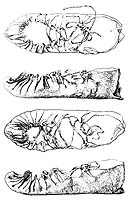 |
||||||||||
|
Lesson #5: Page 10
Unfortunately there is very little in the way of surviving footwear from early Anglo-Saxon England, and what little there is tends to be very fragmentary. What there is, however, does shoe that shoes in England were following the major continental developments, #1 and fortunately there are more surving (or at least reconstructable) shoes on the continent. Shoes were generally of 'turn-shoe' construction. #2 This means that they were sewn together inside out, and then turned the right way around when finished. This has the advantage of keeping all the stitching on the inside of the shoe, making it longer-lasting and more watertight. Open Sandals
The open topped sandal had been the basic shoe type since the early Iron Age (or perhaps earlier) in the Germanic world, and was introduced into the Roman wardrobe in the later Empire, probably brought in by the many Germanic mercenaries. It is simply constructed from a single piece of leather, sewn (or rarely thonged) together at the heel and laced around the toes and over the top of the foot. There is an incredible number of ways to shape the front of the shoe, from versions that expose most of the top of the foot to versions which are almost fully enclosed. Examples from the fourth and fifth centuries in Germany, Holland and Scandinavia are known from bog finds and waterlogged settlement sites, and shoes of this type are also found in sixth century Frankish burials. This type of shoe seems to have been replaced by the enclosed shoe in the sixth century. Click on image for a larger version in a new window
Enclosed One-Piece
Shoes
Click on image for a larger version in a new window Two-Piece Enclosed
Shoes
Click on image for a larger version in a new window
Shoe Fastenings
Continental shoes were sometimes fastened with a small buckle and strap, or might have the long laces carried on up around the calf in a criss-cross pattern tying just below the knee, sometimes with decorartive strap ends. There is no direct evidence for either of these practices being widespread in England. There is also no evidence for the flap and toggle type fastenings seen on later Anglo-Saxon shoes. The top edges of shoes were often decorated (and reinforced) with whipstitching. There are many words for footwear, some of which seem to describe a particular type, but it is now unclear exactly which words represent which type of footwear. These words include scoh ('shoe', a low ankle-boot, shoe or slipper), swiftlere (a rawhide shoe), hemming, rifeling, the bag-like socc and a thonged sandal called a crinc (perhaps similar to the open topped Iron Age footwear). As far as we know all these shoe types could be worn by either sex.
1. There are some continental types which do seem to be absent from the English record, such as those with buckles, but the majority of types were probably similar. back 2. Some
early Frankish shoes are of welted type in the Roman tradition, but there
is no direct evidence of this type being worn by Anglo-Saxons.
However, it is possible later Roman sewn types may have continued to be
made by Britons and thus be available to the Anglo-Saxons, although the
nailed shoes do seem to have vanished. back
|
||||||||||
| Costume
Classroom is a division of The
Costume Gallery, copyright 1997-2001.
Having problems with this webpage contact: questions@costumeclassroom.com |
||||||||||






